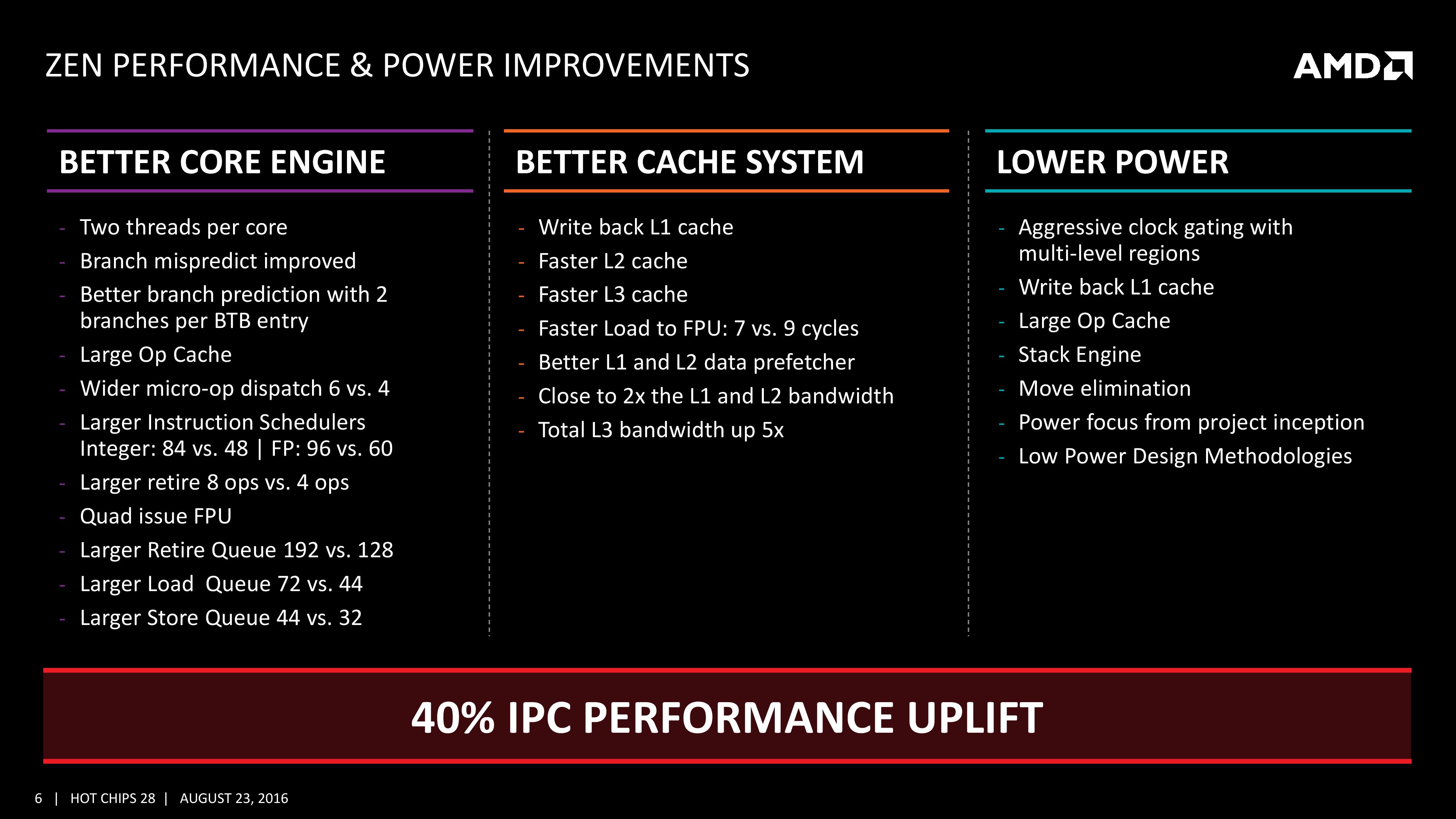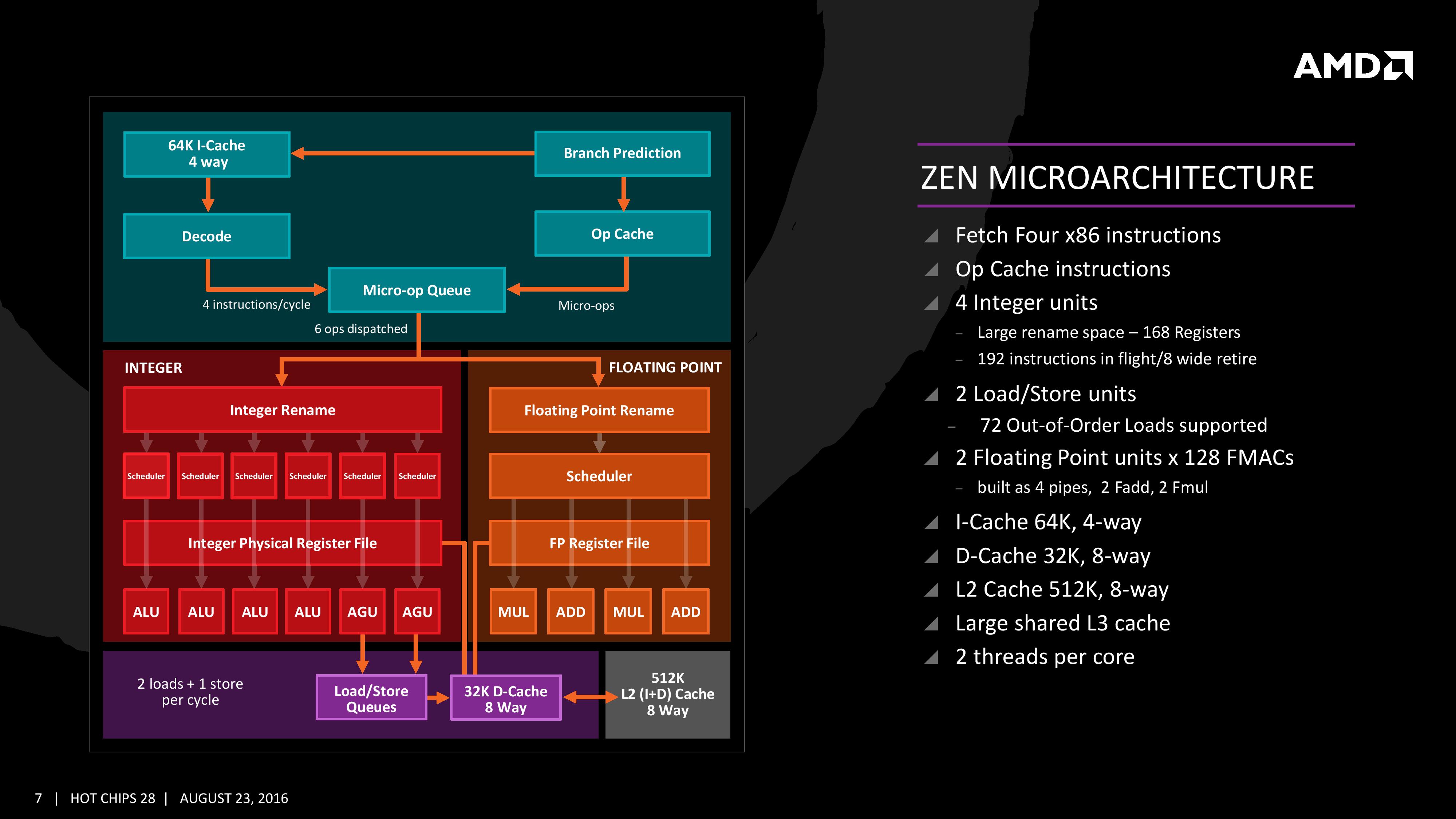AMD Zen Microarchiture Part 2: Extracting Instruction-Level Parallelism
by Ian Cutress on August 23, 2016 8:45 PM EST- Posted in
- CPUs
- AMD
- x86
- Zen
- Microarchitecture
The High-Level Zen Overview
AMD is keen to stress that the Zen project had three main goals: core, cache and power. The power aspect of the design is one that was very aggressive – not in the sense of aiming for a mobile-first design, but efficiency at the higher performance levels was key in order to be competitive again. It is worth noting that AMD did not mention ‘die size’ in any of the three main goals, which is usually a requirement as well. Arguably you can make a massive core design to run at high performance and low latency, but it comes at the expense of die size which makes the cost of such a design from a product standpoint less economical (if AMD had to rely on 500mm2 die designs in consumer at 14nm, they would be priced way too high). Nevertheless, power was the main concern rather than pure performance or function, which have been typical AMD targets in the past. The shifting of the goal posts was part of the process to creating Zen.
This slide contains a number of features we will hit on later in this piece but covers a number of main topics which come under those main three goals of core, cache and power.
For the core, having bigger and wider everything was to be expected, however maintaining a low latency can be difficult. Features such as the micro-op cache help most instruction streams improve in performance and bypass parts of potentially long-cycle repetitive operations, but also the larger dispatch, larger retire, larger schedulers and better branch prediction means that higher throughput can be maintained longer and in the fastest order possible. Add in dual threads and the applicability of keeping the functional units occupied with full queues also improves multi-threaded performance.
For the caches, having a faster prefetch and better algorithms ensures the data is ready when each of the caches when a thread needs it. Aiming for faster caches was AMD’s target, and while they are not disclosing latencies or bandwidth at this time, we are being told that L1/L2 bandwidth is doubled with L3 up to 5x.
For the power, AMD has taken what it learned with Carrizo and moved it forward. This involves more aggressive monitoring of critical paths around the core, and better control of the frequency and power in various regions of the silicon. Zen will have more clock regions (it seems various parts of the back-end and front-end can be gated as needed) with features that help improve power efficiency, such as the micro-op cache, the Stack Engine (dedicated low power address manipulation unit) and Move elimination (low-power method for register adjustment - pointers to registers are adjusted rather than going through the high-power scheduler).
The Big Core Diagram
We saw this diagram last week, but now we get updates on some of the bigger features AMD wants to promote:
The improved branch predictor allows for 2 branches per Branch Target Buffer (BTB), but in the event of tagged instructions will filter through the micro-op cache. On the other side, the decoder can dispatch 4 instructions per cycle however some of those instructions can be fused into the micro-op queue. Fused instructions still come out of the queue as two micro-ops, but take up less buffer space as a result.
As mentioned earlier, the INT and FP pipes and schedulers are separated, but the INT rename space is 168 registers wide, which feeds into 6x14 scheduling queues. The FP employs as 160 entry register file, and both the FP and INT sections feed into a 192-entry retire queue. The retire queue can operate at 8 instructions per cycle, moving up from 4/cycle in previous AMD microarchitectures.
The load/store units are improved, supporting a 72 out-of-order loads, similar to Skylake. We’ll discuss this a bit later. On the FP side there are four pipes (compared to three in previous designs) which support combined 128-bit FMAC instructions. These cannot be combined for one 256-bit AVX2, but can be scheduled for AVX2 over two instructions.












106 Comments
View All Comments
Bulat Ziganshin - Wednesday, August 24, 2016 - link
I think it's obvious from number of ALUs that 40% improvement is for scalar single-thread code that greartly bemnefits from access to all 4 integer ALUs. Of course, it will get the same benefit fro any code running up to 8 threads (for 8-core Zen). But anyway it should be slower than KabyLake since Intel spent much more time optimizng their CPUsFor m/t execution, improvements will be much smaller, 10-20%, i think. Plus, 8-core CPU will probably run at smaller frequency than 4-core Buldozers or 4-core KabyLake. AFAIK, even Intel 8c-ore CPUs run at 3.2 GHz only, and it's after many years of power optimization. We also know that *selected* Zen cpus run at 3.2 GHz in benchamrks. So, i expect either < 3 GHz frequency, or 200 Wt power budget
atomsymbol - Wednesday, August 24, 2016 - link
"For m/t execution, improvements will be much smaller, 10-20%, i think."There are bottlenecks in Bulldozer-family when a module is running two threads. An improvement of 40% for m/t Zen execution in respect to Bulldozer m/t execution is possible. It is a question of what the baseline of measurement is.
Bulat Ziganshin - Wednesday, August 24, 2016 - link
M/t execution in Bulldozer already can use all 4 INT alus, so i think that 40% IPC improvement is impossible. In other words, if s/t IPC improved by 40% by moving from 2 alu to 4 alu arrangement, m/t performance that keeps the same 4 alu arrangement, hardly can be improved by more than 20%looncraz - Wednesday, August 24, 2016 - link
IPC is NOT MT, it is ST only.IPC is per-core, per-thread, per-clock, instruction retire rate... which generally equates to performance per clock per core per thread.
Bulat Ziganshin - Thursday, August 25, 2016 - link
you can measure instruction per cycles for a thread, 3 threads, core, cpu or anything else. what's a problem??My point is that s/t speed on Zen is improved much more than m/t speed, compared to last in Bulldozer family. So, they advertized improvement in s/t speed, that is 40%. And m/t improvement is much less since it still the same 4 alus (although many other parts become wider).
atomsymbol - Thursday, August 25, 2016 - link
AMD presentation was comparing Zen to Broadwell in a m/t workload with all CPU cores utilized.From
http://www.cpu-world.com/Compare/528/AMD_A10-Serie...
you can compute that the Blender-specific speedup of Zen over a previous AMD design is about 100/38.8=2.57
Bulat Ziganshin - Thursday, August 25, 2016 - link
Can you compute IPC improvement, that we are discussing here?looncraz - Thursday, August 25, 2016 - link
Except you're absolutely wrong, the performance increases will be much higher for MT than ST.Bulldozer was hindered by the module design, so you had poor MT scaling - not an issue with Zen. On top of that, Zen has SMT, which should add another 20% or so more MT performance for the same number of cores.
A 40% ST improvement for Zen could easily mean a 100% performance improvement for MT.
Bulat Ziganshin - Saturday, August 27, 2016 - link
It's not "on top of that". Zen is pretty simple Bulldozer modification that fianlly allowed to use all 4 scalar ALUs in the module for the single thread. It's why scalar s/t perfroamnce should be 40% faster. OTOH, two threads in the module still share those 4 scalar ALUs as before, so m/t perfromance cannot improve much. On top of that, module was renamed to core. So, there are 2x more cores now and of course m/t performance of entire CPU will be 2x higherNenad - Thursday, September 8, 2016 - link
It is possible that AMD already count SMT (hyperthreading) into those 40%.Their slide which states "40% IPC Performance Uplift" also lists all things that AMD used to achieve those 40%...and first among those listed things is "Two threads per core". So if AMD already counted that into their 40% IPC uplift, then 'real' IPC improvement (for single thread) would be much lower.